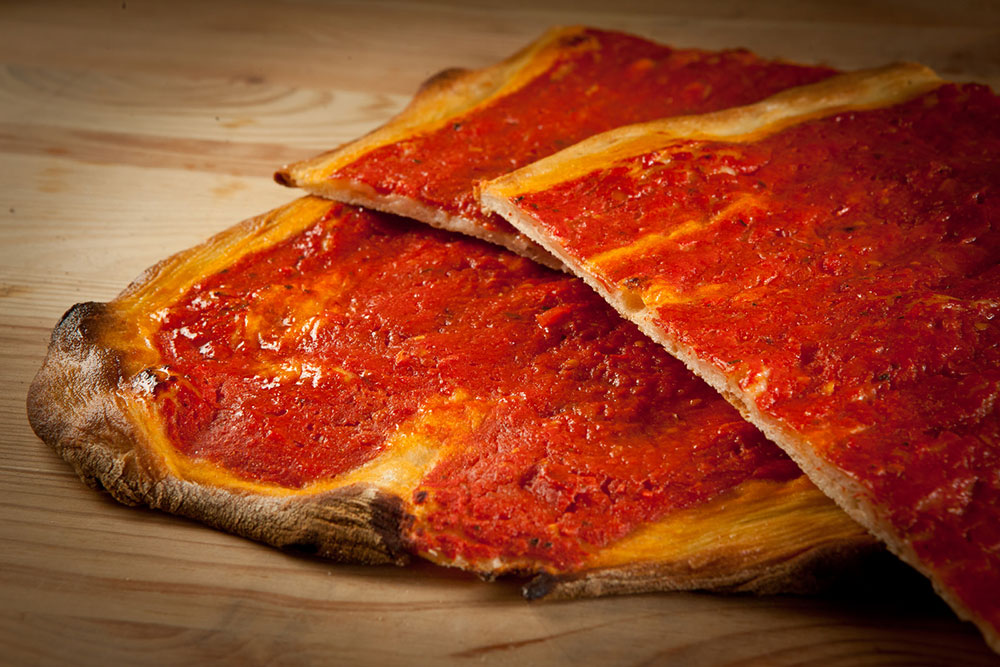
Rome Food Guide

If you’re searching for a place to eat in Rome chances are for an osteria, trattoria, or ristorante.
Historically, an osteria was more of a drinking tavern where you brought your own food, and a trattoria was a place where you’d go for a cheap, quick lunch before returning to work. Today, there’s no significant difference, as both are affordable eateries with Roman food, house wine by the carafe and a casual, living-room atmosphere. Some of that places are still run by families and maintain certain traditions, like the daily specials, like: “Thursday gnocchi, Friday baccala, Saturday trippa.”
The cuisine of the Eternal City that evolved over the millennia had to feed the masses cheaply and efficiently, and flour and water became the basis for a delicious sort of alchemy. But the thrift that inspired cacio e pepe and pizza al taglio also brought about a rich tradition of cooking intestines and offal, employing aggressive amounts of black pepper and funky shepherd’s cheeses, and a love of hardy, bitter vegetables like chicory and artichokes. The result is one of Western Europe’s most complex flavor palettes.
Discover our food itineraries around Italy…join us! ItalyFoodTours

Like in most Italian cities, a meal in Rome is traditionally split into Five Courses. It begins with a simple Antipasto — usually cured meats and fried or marinated vegetables. Then, Primo, often one of the “big four classic” Roman pastas.
After that, there’s Secondo, a piece of meat, often stewed or roasted, or fish like baccala with contorni (side dishes) ordered separately, like sauteed greens or roasted potatoes. Dolce & Fruit….from tiramisu to a plate of pineapple. Then comes coffee, and then finally a digestive, a high-proof liqueur like grappa, limoncello, or amaro.
It’s important to note that these five courses are the theoretical maximum, not minimum, you absolutely do not need to order every course.

Pasta
Most Italian cities have one or two classic pastas that are known outside of Italy. Rome has four: cacio e pepe, carbonara, gricia and amatriciana.
All of them are based around Rome’s iconic sheep’s milk cheese, pecorino romano. Three of the four pastas also feature guanciale, cured pork jowl that gets cubed and rendered into the sauce.
Pasta with chickpeas is traditionally served on Fridays and gnocchi on Thursdays, garnished with tomato or amatriciana sauce.
These are some of the masterpieces of the roman food.

Pizza
Probably the most widely consumed food in Rome, Roman Pizza is different than the famous Neapolitan, and comes in two forms: al taglio (by the slice) and tonda (classic round pizza).
Join us and discover the world of Pizza in Rome with a guided tour of the city…will be a memorable day together! Pizza Tour in Rome
Pizza al taglio is usually lunch or a snack. The word “pizza” in Rome is actually a the type of bread: flat, crisp, and sturdy. Pizza bianca, is garnished with only oil and salt, often cut in half and made into a sandwich with mortadella in between. Other common toppings include potatoes, the classic margherita, sausage with mushroom, or “rossa” ( just plain tomato).
Whatever the toppings, the system is always the same. Long pies, either rectangular and baked in sheet pans (in teglia), are arranged behind the counter and listed with a price per kilo. An employee cuts slices with a knife or scissors, weighs them, reheats them in a small oven, and then hands them to the customer either on a cardboard plate or wrapped in wax paper.
Pizza tonda, or round pizzas, are thin and crispy, unlike the thicker and chewier Neapolitan style, and are usually offered at sit-down pizzerie for dinner. Cooked in a wood oven, they come topped with anything from margherita to squash blossoms, mozzarella, and anchovies and are best washed down with pizza’s universal beverage pairing: cold beer.

Romans appetizer is fried: meatballs, fish, but most of all vegetables or suppli.
At a pizzeria, one typically starts with a platter of fried snacks, which might include fiori di zucca (fried squash-blossoms stuffed with mozzarella and anchovies) or fritto misto vegetale (a mix of vegetables).
The most popular fried treat, though, is supplì, a fried rice ball that was traditionally made with a ragu of chicken livers, but now is more likely stuffed with mozzarella and flavored with tomato. They’re sometimes called supplì al telefono, because the melted cheese stretches into a long cable when the supplì is pulled apart, resembling the cord of an old-fashioned telephone.
Feel free to join us for a special street food tour in Rome and discover the city with different tastings and a local tour guide by your side. Street Food Tour Roma

Gelato
Right along with Michelangelo and Leonardo, Aqueducts, and Galileo’s theories on planetary movement, Gelato is easily one of Italy’s greatest cultural contributions and Rome is one of the best places to find it.
Around the city there are a lot of gelaterie displaying their beautiful and tasty flavors.
A classic question inside the gelateria when you’re in the front of some beautiful flavors will be: “Cup or Cone?”
But finding truly great gelato isn’t easy. If you’re searching an original one that using fresh ingredients and good-quality products, you must searching for a “gelato “artigianale” (or artisanal). It’s sure you will feel the difference with the commercial gelato!
Join us for a fantastic Gelato Tour and discover the city together Gelato Tour in Rome
Avoid flavors featuring unnaturally with brightly colored (fluorescent green instead of naturally pale green-brownish pistachio, for example) and opt instead for those showcasing seasonal fruit. But at the end of the day, let the gelato speak for itself: A perfect gelato should be creamy but not too fatty, with no ice crystals and a clean taste that isn’t overpowered by milk or sugar.
Enjoy a nice walking around the city and discover with us the best ice-cream in Rome…will be funny to taste more than a gelato in the city centre and feel the difference!
